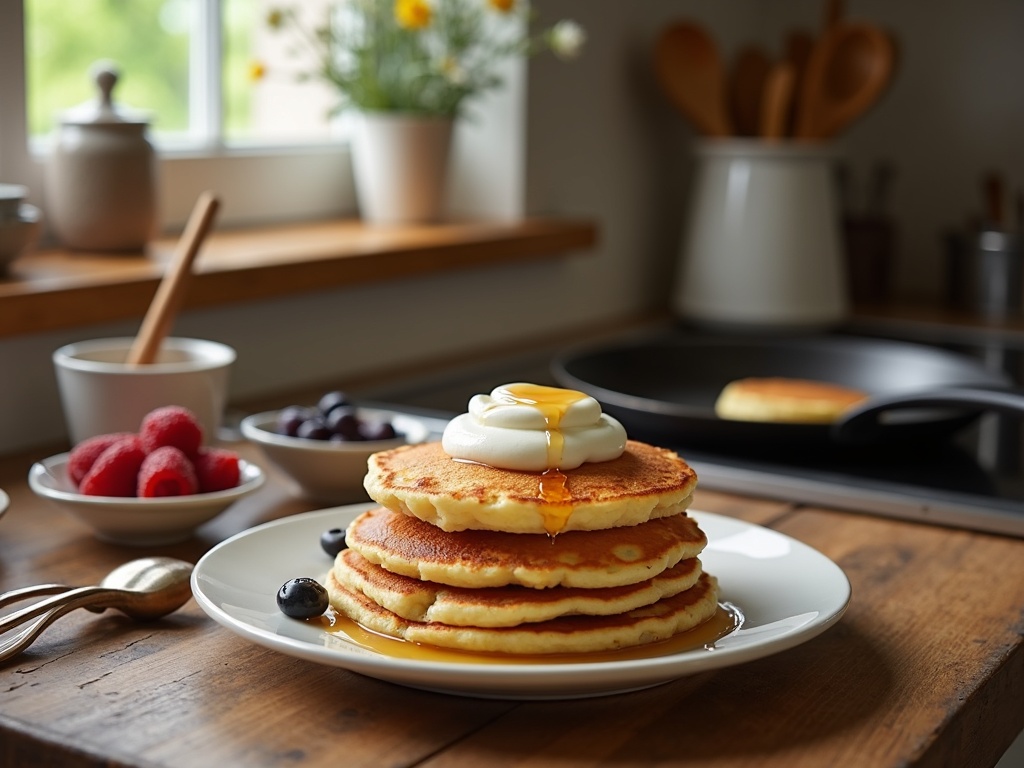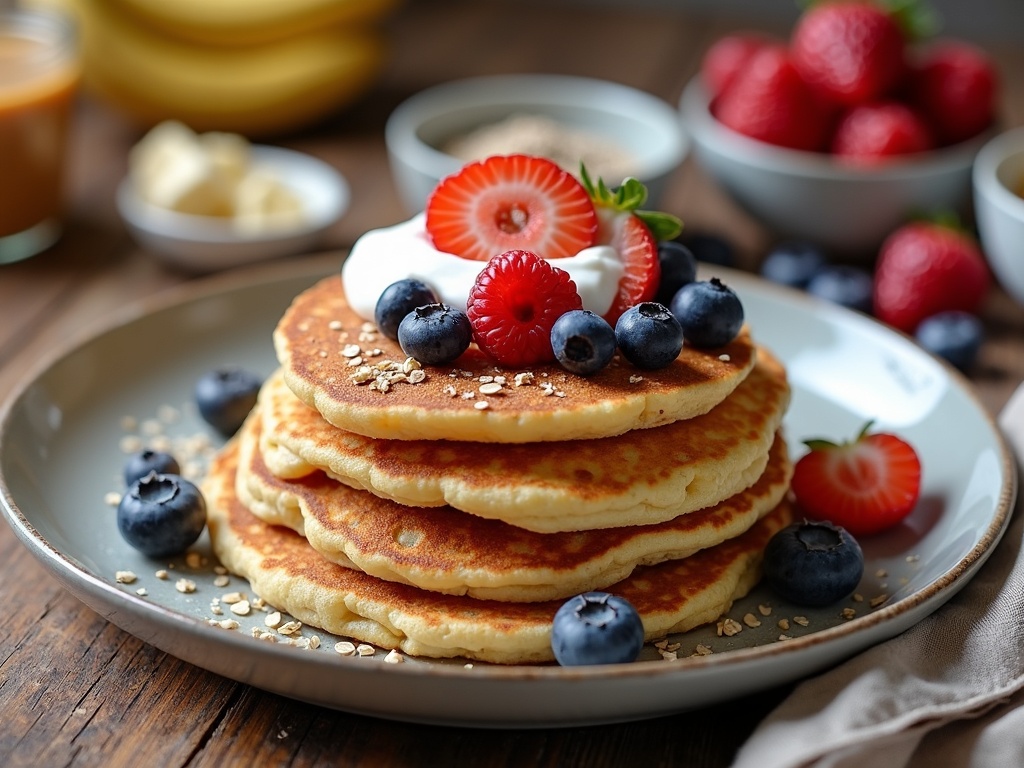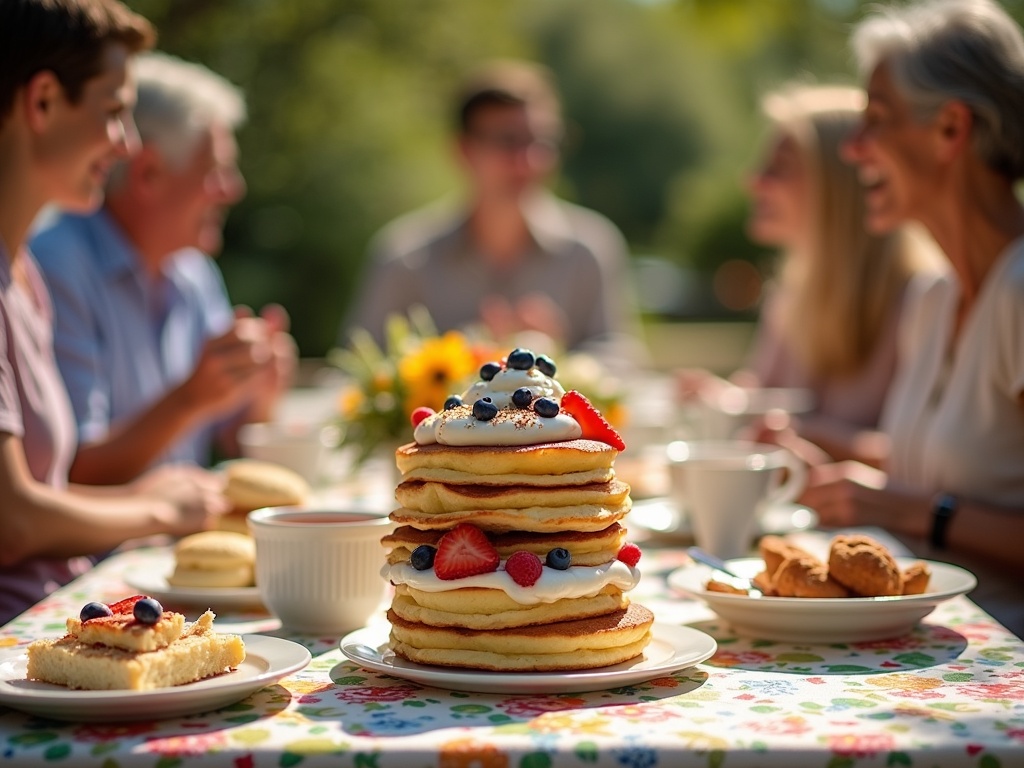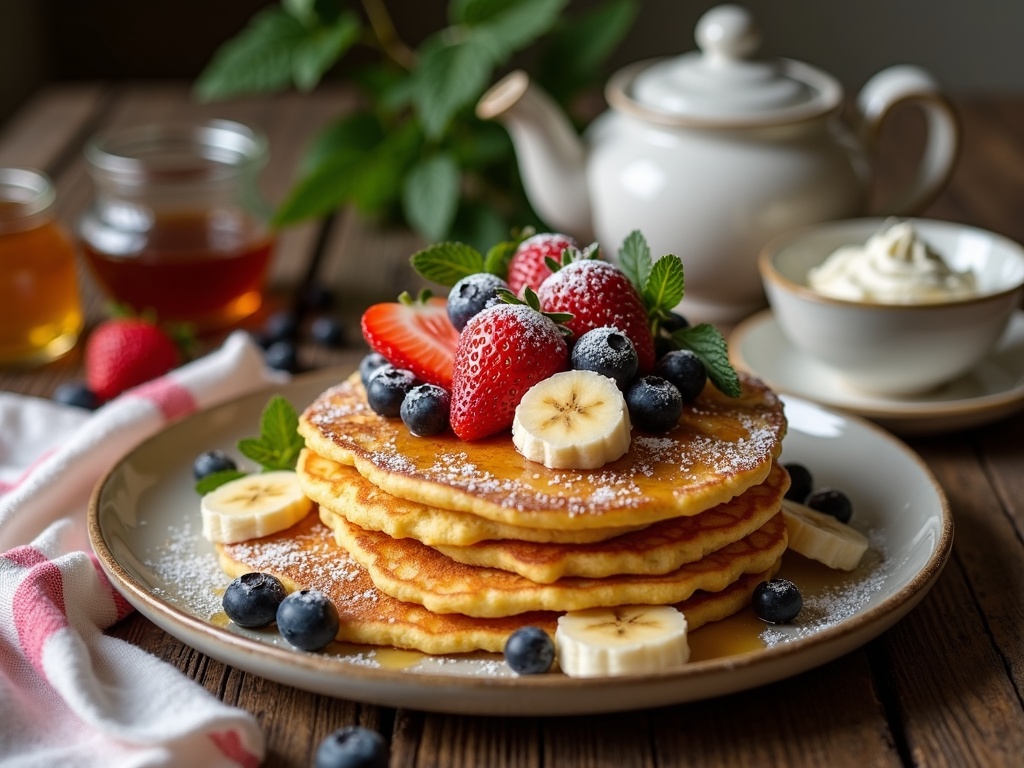Pikelets are beloved mini pancakes that originated in Australia and New Zealand, characterized by their thick, fluffy texture and compact 4-5 inch diameter. Unlike American pancakes, these treats feature a spongier interior due to additional raising agents and have evolved from British crumpets into a distinctly Australian culinary tradition that’s perfect for tea time, children’s parties, and casual gatherings.
Find In This Article
Key Takeaways
- Pikelets have a distinctive thick, fluffy texture with a spongy interior that differentiates them from regular thin pancakes.
- The basic pikelet recipe requires simple pantry ingredients like self-raising flour, milk, eggs, and sugar, making them easy to prepare on short notice.
- A medium-heat pan and proper batter consistency (similar to heavy cream) are crucial for achieving the perfect golden-brown exterior and fluffy interior.
- Pikelets are versatile and can be served with both sweet toppings like jam and cream or savory additions like cheese and chives.
- These treats hold significant cultural importance in Australia and New Zealand, representing intergenerational connections as recipes are passed down through families.
The Ultimate Comfort Food: Pikelets vs Regular Pancakes
Pikelets stand as a beloved culinary icon in Australia and New Zealand, measuring just 4-5 inches in diameter. I’ve found these mini pancakes aren’t simply scaled-down versions of their larger counterparts—they possess a unique character all their own.
What Makes Pikelets Special
The defining characteristic of pikelets is their delightfully thick and fluffy texture. Unlike American-style pancakes that spread thin on the griddle, pikelets maintain a compact, raised profile with a spongy interior. This texture difference comes from their batter, which typically contains more raising agent and is slightly thicker than regular pancake mix.
Pikelets have an interesting heritage, having evolved from British crumpets. Over time, they’ve transformed into a distinctly Australian treat, shedding the yeast-based recipe of traditional crumpets in favor of a quicker baking powder rise. While crumpets require special rings to maintain their shape, pikelets are freeform, making them much easier to prepare at home.
These small treats have secured their place in Australian food culture for several good reasons:
- They’re perfect for tea time, offering just the right amount of sweetness without overwhelming the palate
- They’re ideally sized for children’s parties, where little hands can manage them easily
- They work wonderfully for casual gatherings, requiring no cutlery and minimal cleanup
The versatility of pikelets extends to their toppings as well. While they’re traditionally served with jam and whipped cream, modern variations might include:
- Fresh berries and maple syrup
- Honey and banana slices
- Lemon curd and mascarpone
For those looking to expand their baking repertoire, pikelets make an excellent starting point. They’re less fussy than scones and more forgiving than traditional pancake recipes, yet still deliver that homemade comfort food satisfaction.
The beauty of pikelets lies in their simplicity—basic pantry ingredients transform into something special in just minutes. Unlike many desserts that require planning and precision, pikelets can be whipped up on a whim when unexpected guests arrive or when you simply need a sweet pick-me-up with your afternoon tea.
How to Make Perfect Pikelets Every Time
Pikelets have been a staple in my kitchen for years, and I’ve found that achieving that perfect golden-brown finish with a light, fluffy center isn’t complicated once you understand the fundamentals. These small, circular treats are similar to pancakes but typically smaller and slightly thicker, making them perfect for afternoon tea or a quick breakfast option.
The basic ingredients for pikelets couldn’t be simpler. I start with self-raising flour (or plain flour with baking powder), milk, eggs, and a touch of sugar. These pantry staples combine to create a batter that, when cooked properly, transforms into delicious mini pancakes that can be enjoyed hot or cold.
Mastering the Pikelet Technique
The key to perfect pikelets lies in getting the batter consistency just right. I aim for a thickness that’s similar to heavy cream – it should pour easily from the spoon but not be too runny. If your batter is too thick, your pikelets will be stodgy; too thin, and they’ll spread too much and lack that characteristic fluffiness.
I’ve found several tips helpful when preparing pikelets:
- Let the batter rest for 10-15 minutes before cooking to allow the gluten to relax and the baking powder to activate.
- Use a hot, lightly greased non-stick pan or griddle for cooking.
- Pour small amounts of batter (about 2 tablespoons) to form 7-8cm rounds.
- Cook for approximately 2 minutes on the first side until bubbles form and pop on the surface.
- Flip once and cook for another 1-2 minutes until golden brown.
Temperature control is crucial when cooking pikelets. I keep my pan at medium heat – hot enough to create that lovely golden color but not so hot that the outside burns before the inside cooks through. A properly heated pan will give you that signature golden-brown exterior while ensuring the inside is fully cooked and fluffy.
For those with dietary preferences or restrictions, pikelets are wonderfully adaptable. I’ve successfully made them using whole wheat flour for added fiber, or gluten-free alternatives for those with sensitivities. The sweetener can also be varied – sometimes I swap the sugar for honey or maple syrup for a different flavor profile.
Pikelets are best enjoyed fresh, but they also store well for a couple of days. I often make a larger batch and keep them in an airtight container. They make fantastic lunchbox fillers or quick snacks, especially when paired with jam, honey, or fresh fruit.
For a more substantial breakfast option, I sometimes add mashed banana or berries to the batter before cooking. This creates delicious fruit pikelets that pair wonderfully with a dollop of yogurt. If you’re looking for more sweet treats that are simple to prepare, exploring various dessert recipes can provide inspiration for pikelet toppings or complementary dishes.
While pikelets share similarities with American pancakes, they have their own unique texture and tradition. Their smaller size makes them perfect for serving at afternoon tea alongside a selection of spreads, allowing guests to sample different flavor combinations.

Nutrition Facts and Health Benefits
Pikelets make a delightful treat that can fit into a balanced diet when enjoyed in moderation. Each serving of two pikelets contains approximately 90-100 calories, making them a relatively light option compared to other baked goods. The carbohydrate content sits around 20g per serving, with about 2g of protein and less than 1g of fiber.
Nutritional Profile
The modest calorie count in pikelets makes them a sensible choice for a light breakfast or afternoon snack. Their nutritional makeup is straightforward:
- 90-100 calories per standard serving (2 pikelets)
- 20g carbohydrates per serving
- 2g protein per serving
- Less than 1g fiber per serving
I’ve found that pikelets offer a healthier alternative to traditional American pancakes, especially when made with whole grain flours. Using whole wheat flour or adding a portion of oat flour can significantly increase the fiber content, making them more filling and nutritionally dense.
Boosting Nutritional Value
The basic pikelet recipe serves as an excellent canvas for nutritional enhancements. I can transform this simple treat into a more balanced snack by incorporating thoughtful additions and modifications.
Using alternative milk options like almond, soy, or oat milk can reduce the overall calorie content while potentially adding other nutrients depending on the fortification of the milk alternative. For those watching their sugar intake, using unsweetened milk alternatives makes an appreciable difference.
The toppings chosen can dramatically impact the nutritional profile of pikelets. Rather than reaching for butter and syrup, I’ve had great success with these healthier alternatives:
- Fresh berries or sliced fruit add natural sweetness, fiber, vitamins, and antioxidants
- A dollop of Greek yogurt provides extra protein and probiotics
- A light spread of nut butter offers healthy fats and additional protein
- A sprinkle of seeds like chia, flax, or hemp adds omega-3 fatty acids
Adding ingredients directly to the batter can also enhance the nutritional profile. Mashed banana not only adds natural sweetness, similar to a banana loaf recipe, but also contributes potassium and fiber. Grated apples or pears can add moisture, natural sweetness, and additional fiber.
For those looking to increase protein content, adding a scoop of protein powder to the batter works surprisingly well. I’ve found that vanilla-flavored protein powder complements the natural taste of pikelets without overpowering them.
The portion size matters significantly when considering the nutritional impact of pikelets. Sticking to the standard serving of two pikelets helps keep calorie and carbohydrate intake in check, especially when enjoying them as part of a dessert rather than a main meal.
While pikelets themselves aren’t particularly high in essential nutrients, they can still be part of a balanced diet. Their versatility makes them an ideal vehicle for more nutritious toppings, turning a simple treat into a more complete snack that satisfies both nutritional needs and cravings for something sweet.

Sweet and Savory Serving Ideas
Pikelets are incredibly versatile little treats that can be dressed up in countless ways. I’ve experimented with numerous toppings over the years and found that both sweet and savory options can transform these simple pancakes into something extraordinary.
Traditional and Modern Sweet Options
The classic approach to serving pikelets involves spreading them with a generous layer of butter while they’re still warm, allowing it to melt slightly before adding a dollop of jam. This timeless combination brings out the subtle sweetness in the pikelet batter. For special occasions, I top mine with freshly whipped cream and seasonal berries for a delightful breakfast treat.
Fresh fruits elevate pikelets to new heights. Try these delicious combinations:
- Sliced strawberries with a drizzle of honey
- Blueberries with a sprinkle of powdered sugar
- Caramelized bananas with a touch of cinnamon
- Diced apples sautéed with brown sugar
For those with a serious sweet tooth, modern additions like chocolate chips folded into the batter create pockets of melty goodness in each bite. I’ve found that adding warm spices like cinnamon, nutmeg, or vanilla extract to the batter adds depth and complexity without overpowering the delicate pikelet flavor.
Savory Options
Savory pikelets offer a completely different experience and make perfect appetizers or light lunch options. I often prepare a batch with grated cheese and freshly chopped chives mixed directly into the batter. The cheese creates crispy edges while the chives add a mild onion flavor that pairs beautifully with the soft texture.
Another savory favorite combines spinach and crumbled feta cheese. The earthy spinach and tangy feta create a satisfying flavor combination that works wonderfully for brunch gatherings.
For those feeling adventurous, fusion combinations bring exciting twists to traditional pikelets. Try incorporating ingredients like corn and jalapeños for a Tex-Mex inspired version or sesame seeds and green onions for an Asian-inspired variation. These creative combinations keep pikelets feeling fresh and relevant for contemporary palates.
Whether served as a sweet breakfast treat or savory snack, pikelets remain a versatile canvas for culinary creativity. Their pillowy texture and simple flavor profile make them perfect for exploring diverse topping combinations that span traditional favorites and bold new experiments.
Cultural Significance in Australian Life
Pikelets hold a special place in Australian culture that goes beyond their delicious taste. I’ve found these small, fluffy treats to be one of those foods that instantly transport Australians back to childhood memories and family gatherings. They’ve become much more than just a quick snack – they’re a cultural institution that bridges generations.
A Centerpiece of Social Gatherings
Afternoon tea in Australia wouldn’t be complete without a stack of freshly made pikelets. These light, pancake-like treats have been a staple at social gatherings for decades, often served alongside homemade scones and tea sandwiches. Their popularity stems from their simplicity and versatility – they can be dressed up with fancy toppings for more formal occasions or served plainly with just a spread of butter and jam for casual get-togethers.
Children’s birthday parties across Australia regularly feature pikelets as a guaranteed crowd-pleaser. I’ve noticed they’re particularly popular because:
- They can be prepared in advance and served at room temperature
- They appeal to picky eaters and adventurous food lovers alike
- They’re easy for small hands to manage without creating too much mess
- They serve as a perfect base for creative toppings that match party themes
- They’re cost-effective for feeding large groups of hungry children
What makes pikelets particularly interesting is their ability to transition between casual and formal settings. At backyard barbecues, they might appear as a sweet finish to the meal, while at high tea events, they can be elegantly presented with whipped cream and fresh berries. This adaptability has cemented their place in various social contexts throughout Australian life.
The pikelet’s significance extends beyond mainland Australia to New Zealand, where they enjoy similar cultural status. Both countries have embraced these treats as part of their food heritage, though slight regional variations exist in recipes and serving styles. Unlike American pancakes which are typically thicker, pikelets maintain their distinct identity in Oceania.
Their presence in Australian and New Zealand food culture represents a fascinating fusion of British culinary traditions with local adaptations. The pikelet evolved from British crumpets and pancakes but developed its own characteristics suited to the Australian lifestyle and available ingredients. This evolution mirrors Australia’s broader cultural journey – respecting historical connections while forging a unique identity.
For many Australians, learning to make pikelets represents a rite of passage in the kitchen. The simple recipe makes them an ideal first cooking project for children, creating intergenerational bonds as recipes and techniques are passed down. I’ve seen families treasure their specific pikelet recipes, with subtle variations becoming points of pride and friendly competition at community events and family dessert gatherings.
Through changing times and evolving food trends, pikelets have maintained their relevant place in Australian culture, adapting to contemporary dietary preferences while preserving their essential character. Whether served with traditional toppings or modern twists, they continue to bring people together around the table – a humble yet significant thread in the fabric of Australian culinary identity.

Making Them Your Own
I’ve found that the beauty of pikelets lies in their versatility. These small, fluffy pancakes can be customized in countless ways to suit your taste preferences and dietary needs.
Creative Variations and Serving Ideas
Adding your own twist to basic pikelet recipes keeps this classic treat exciting. Some community-inspired variations I’ve tried include folding through fresh blueberries, mashed banana, or a sprinkle of cinnamon for a flavor boost. For those seeking healthier options, swapping in whole wheat flour for half the regular flour adds fiber without sacrificing the soft texture that makes quick pancakes like pikelets so delightful.
When serving pikelets for family gatherings, I set up a topping station with:
- Fresh fruit slices and berries
- Honey and maple syrup
- Yogurt and whipped cream
- Nut butters for protein
- Jam or preserves
This interactive approach makes breakfast or afternoon tea more engaging, especially for children who enjoy creating their own pikelet masterpieces.
Getting the texture just right can make or break your pikelets. I’ve learned to avoid overmixing the batter – those few small lumps actually help create a lighter texture. Letting the batter rest for 10-15 minutes before cooking allows the gluten to relax and the raising agents to activate properly.
For perfectly consistent pikelets, I use a measuring tablespoon to portion the batter onto the griddle. This ensures they cook evenly and look professional when served alongside lemonade scones or other tea-time favorites.
Pikelets store surprisingly well. I keep leftovers in an airtight container in the refrigerator for up to three days. When reheating, a quick 10-second burst in the microwave works wonders, though toasting them lightly also restores that fresh-made texture and adds a pleasant crispness to the edges.
The changing seasons offer inspiration for different topping combinations. In summer, I pair pikelets with fresh berries and a light honey drizzle, while autumn calls for sautéed apples with cinnamon. Winter favorites include citrus segments with a dusting of powdered sugar, and spring brings opportunities for delightful dessert variations with fresh mint and early strawberries.
Don’t forget that pikelets can swing savory too. I’ve served them with smoked salmon and cream cheese for brunch gatherings, and they’re always a hit.
Sources:
Bon Appétit – The Ultimate Guide to Pancakes
Australian National Foods Article – Traditional Australian Cuisine
USDA National Nutrient Database – Nutritional Information of Common Breakfast Foods
Food Network Australia – Pikelets: A Sweet Treat

